#pancha tantra
Explore tagged Tumblr posts
Photo

(vía the-sensorium-walton-ford.jpg (1844×933))
Walton Ford. Acuareliste. “The Sensorium”, 2003. “Pancha Tantra”
8 notes
·
View notes
Text
thanks for the tag, @gnawing-suspicion and @singingrottenbones! 🖤
tagging @t3acupz, @valentinsylve, @coffee-in-rain, @fracturescope
@fatalism-and-villainy, @hold-the-devil-well, @localwhiskeyuncle, @celta-diabolica,
@resomated, & @bite-motif
28 notes
·
View notes
Text






Book 576
Pancha Tantra
Walton Ford
Taschen 2009
Walton Ford (b. 1960) is an American artist whose work mimics the style of naturalist illustrations, in particular those of the colonial era and often featuring extinct species. Highly symbolic and allegorical, offering clues, jokes, and references to relevant texts and other works, Ford’s paintings call out the horrors and hubris of colonialism, politics, natural history, industrialism, and humanity’s deleterious effect on the environment.
While not the first published collection of his work, Pancha Tantra is certainly the most impressive. Measuring 11.5” x 15”, 320 pages, and weighing around 8 lbs., the book offers a thrilling array of Ford’s work from the early 90s to the early aughts. While at first glance a Ford painting may appear to be a 19th century naturalist painting, there is something not quite right about it. In Diagnosis (1996), European starlings are practically being swallowed by Black-necked stork, whose namesake neck is bent back in an awkward and disturbing way. In Atma (1998), a reticulated python balances a caged lorikeet on its head. In Chingado (1998), a Brahmin bull is being suffocated by a jaguar, jaws clenched tight to the bull’s face and neck. The key to these works lies in the details: the notes scribbled in pencil along the margins, a brand on an animal’s hide, a piece of fruit from a specific part of the world is eaten by animal from another, a Latin inscription, a tiny creature being carelessly trampled underfoot by a much larger one.
Nature in Ford’s world is much more than simply “red in tooth and claw”, it is relentless and brutal, caused as much by need as by indifference and avarice, where species lost to consumption are not just cautionary tales, but premonitions.
#bookshelf#personal collection#personal library#books#library#bibliophile#book lover#illustrated book#booklr#natural history#art#pantra tantra#walton ford#taschen
13 notes
·
View notes
Text
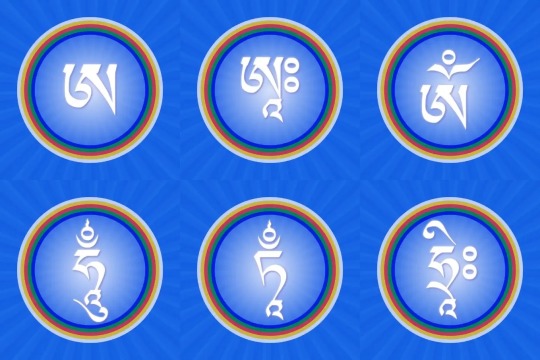
The Seed Syllables
The following figure shows a mosaic of all the seed syllables (skrt: bijas). Bija literally translated means "seed", and in the case of sacred syllables, can be taken to mean "mystical symbols and sounds which represent root attributes of the cosmos, manifest and unmanifest". The bijas carry with them great power and influence. The Vedic creation myths state that the scripture was "heard" (skrt: sruti), and was later encoded into the Sanskrit language, as such the sound and visual representation connects directly to that ancient power (skrt: apauruseya). When used in meditation, visualization, and sound, the practitioner can connect directly with the primordial nature of each bija.
The bijas are (from top clockwise):
* A (tib: a)
* AH (tib: AH)
* OM (tib: oM)
* HUM (tib: hU~M)
* TAM (tib: tAM)
* HRIH (tib: hrIH)
Hidden Symbology
While researching this project, it was fascinating to learn more about the hidden symbolism which appears in Buddhist imagery, specifically Tibetan Vajrayana and Dzogchen (tib: rdzogs chen) in particular. While the images in this collection appear simple in their design, they are expressing ancient esoteric teachings encoded into symbols.
For the images of this collection, two core teachings were used to encode the symbols: Annutara Yoga Mother class Tantra (Vajrayogini, left-hand tantra), and Ati Yoga Dzogchen's second Rigpa (skrt: vidya, tib: rig pa) wisdom lhun grub.
Working from the outermost symbol inwards, we have:
Rays of Light
Rays of light emanate from the center-point on a background of royal-blue sky.
Five Spherical Rings
On an exoteric level the rainbow-like rings represent the five elements (skrt: pancha bhuta, tib: 'byung ba lnga) as described in Vajrayana:
* Ether, Space (Vyoma, Akasa): White, Vairochana, KHAM
* Air (Vayu): Green, Amitabha, YAM
* Fire (Agni): Red, Akshobhya, RAM
* Water (Varuna): Blue, Ratnasambhava, VAM
* Earth (Prithivi, or Bhumi): Yellow, Amoghasiddhi, LAM
On an esoteric level the rings have a vast interpretation that can consume a lifetime (or more) of study.
Mother Tantra: To understand the way in which the female tantra is symbolized in the images, we must first consider the Pancha Jina Buddha Mandala. Five Victorious Buddha Mandala is one of the primary formulations of the bliss-body (skrt: sambhoga kaya), and a way to conceptualize Buddhahood in meditation and art.
In the male tantras, this mandala is visualized clockwise beginning from the eastern direction (bottom in the mandala). Directionally, this would be:
* East (Blue, Bottom, Akshobhya, HUM)
* South (Yellow, Left, Ratnasambhava, TRAM)
* West (Red, Top, Amitabha, HRIH)
* North (Green, Amoghasiddhi, AH)
* Zenith (White, Center, Vairochana, OM)
However, in the female tantras the eastern and zenith position are switched and one visualizes in a counterclockwise direction beginning at the zenith, hence the name "left-hand".
Encoding: Rings as the female tantra version of the Pancha Jina Buddha Mandala as a completion-stage "inner-offering".
It's important to note (and visualize) the colors starting inside with blue and working counterclockwise outwards to white. We are beginning at the zenith, at emptiness.
Dzogchen: With the second Rigpa wisdom lhun grub, the rings take on another level of meaning which builds upon the previous mandala. The lhun grub teachings state that the "rainbow body" (tib: 'ja' lus) is a level of realization, or full enlightenment and the self-liberation of the human body into a non-material body of light. The "rainbow body phenomenon" is the third party observation (spheres of rainbow light) of the moment when a practitioner attains the rainbow body (sambhoga kaya) at death.1 In Dzogchen this concept (lhun grub) is symbolized as a set of spherical rings called thigle (tib: thig le).
Encoding: Rings as a thigle, the rainbow body, and spheres of rainbow light.
Vajra Midpoint, Bindu, and Emptiness
The vajra (tib: rdo rje) is a symbol, like the rings, which can consume an entire lifetime (or more) of study. Focusing on Tibetan Buddhism and the esoteric viewpoint, the vajra is a symbol of an adamantine state of existence and embodies emptiness (skrt: shunyata). The center of the vajra represents the Null state, where Samsara emerges, regenerates, and disintegrates. On one side of the vajra is Phenomena, and on the other is Noumena.
The Sanskrit meanings for the word bindu(the point or dot at which creation begins, and the starting place of the mandala) is another way to approach this metaphysical imagery.
Encoding: Central burst of white light as shunyata, the Null state of the vajra, and the bindu (dot or point). The bijas (seeds) emanate out of the point, out of emptiness, and merge back into the same. The female bindu and the male bija giving birth to the cosmos.
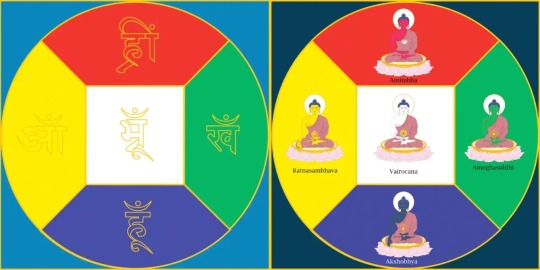
9 notes
·
View notes
Text

"Five activities are essential in the observance of our quest. These are known in the Tantras as the Pañcha Makaras. These translate as wine (madya), meat (māṃsa), fish (matsya), parched grain (mudrā) and sexual involvement (maithuna). These are the five sacraments that are typical of Tantric sadhana (Tantric praxis).
According to the Tantric philosophy, the sexual union leads to the ultimate union. But this union is not to procreate. Through the sexual union, one consecrates a Goddess. In such a consecration, a Tantric employs what is known as the offering of the nine flowers: embracing (ālingana), kissing (chumbanam), fondling the breasts (stana mardana), biting (danta karmam), touching (sparśanam), extending the vagina, pressing the penis, entry, and lastly, penetration (pravesham). These are known amongst Tantrics as flowers in the practice of maithuna. With this, are recited stanzas and mantras. With maithuna, the kuṇḍalinī is guided to its place of origination (Sahasrāra) to experience the bliss that delivers one from devolving (rebirth). Through this regression, the individual self that is embodied by She, the Kuṇḍalinī Śakti, is relinquished to experience the grace of the Parama Śiva (The Ultimate Conscious Self liberates us--Jīvan Mukta.) It is impossible to describe the feelings and sensations that a Tantric couple experience during this union of the Śiva-Śakti at the Sahasrāra (Thousand-petalled Lotus).”
Pranatosh Baba
Side note: while the 5 M's/Pancha makaras are a big part of Tantra, they are not compulsory in all strands - schools of vamachara will participate in these arms literally, while those in a daksinacara for example, will use them symbolically.
Sex and the other aforementioned activities are of course a part of Tantra, but many westerners mistakenly conflate the vamachara practices and sexual rites as instrumental to all Tantric practices.
In the Tantraloka, a confluence of tantric practices, it is mentioned that many of the intense and transgressive yogic practices are valid, yet not a necessity and the most important aspect of Tantra is the meditation on Lord Siva.
#esoteric#occult#hinduism#shiva#tantra#goddess#shakti#bhairava#sanatanadharma#spirituality#religion vedic
4 notes
·
View notes
Text
Finally cracked into my Walton Ford Pancha Tantra Book and he’s such a pervert after my own heart
2 notes
·
View notes
Photo
alrauna:
Walton Ford
The Damnation of Faust
Watercolour, gouache, pencil, and ink on paper, 2008
From Pancha Tantra

442 notes
·
View notes
Link
ચકલી અને કીડી | Chakli ane Kidi | Navi Varta | The Bird and Ant Story | Gujarati Cartoon | Gujarati Moral Story | Gujarati Varta KidsOne Gujarati | KidsOne Gujarati #ચકલી અને કીડી #GujaratiStories #GujaratiVarta #KidsOneGujarati
#gujarativarta#gujaratistories#kidsonegujarati#panchatantra#moralstories#kids stories#Pancha Tantra#moral stories
0 notes
Text


Walton Ford: Pancha Tantra- published by Taschen
Transcription:
Novato Zemlya Still Life/ - - - The 6th of September, some of our men went on shore upon the firm land to seek for stones, which are a kind of diamond [rock crystal], whereof there are a many... and while they are seeking the stones, two of our men lying together in one place, a great lean white bear came suddenly stealing out, and caught one of them fast by the neck, who not knowing what it was that took him by the neck, cried out and said, "Who is it that pulls me so by the neck?"
Wherewith the other, that lay not far from him, lifted up his head to see who it was, and perceiving it to be a monstrous bear, cried and said "Oh, mate, it is a bear!" and therewith presently rose up and ran away.
The bear at the first falling upon the man, bit his head in sunder and sucked out his blood, wherewith the rest of the men that were on land, being about 20 in number, ran presently thither, either to save the man, or else to drive the bear from the dead body; and having charged their pieces and lowered their pikes, set upon her, that was still devouring the man, but percieving them to come towards [her] she fiercely and cruelly ran at them, and got another of them out from the company, which she tore in pieces, wherewith all the rest ran away./ - - - Dutch explorer Willem Barentz's (1550-1597) Artic expedition in 1569 to find a northeast passage to Asia was chronicled by crewmen Gerrit de Veer in TRUE AND PERFECT DESCRIPTION OF THREE VOYAGES BY THE SHIPS OF HOLLAND AND ZEALAND 1609.

Walton Ford, Novaya Zemlya Still Life, 2006, watercolor/paper (Wadsworth Atheneum, Hartford)
86 notes
·
View notes
Text
Universe in Body Qualities Water Fire Air Earth Space By Siva
The inquisitiveness of Man keeps him going. Accepting things as they are is the Attribute of the Realized Soul that arises from Supreme knowledge. But not all are blessed to Realise Reality.As ordinary mortals we are intrigues by things, events and wonder why Things/Events are what the Are and How. Siva as Virata PurushaSiva in Various Forms. Answer to both questions are difficult. We can…
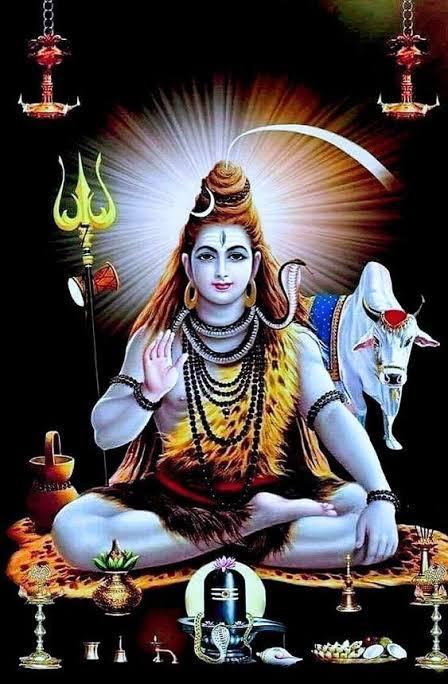
View On WordPress
#சிவ தந்திரம்#ஜன சங்காலினி தந்திரம்#தந்திர யோகம்#பஞ்ச பூத தந்திரம்#வாசி யோகம்#Janasankalani Tantra#Pancha Butas Tantra#Perception Hinduism#Siva on Elements#SivaTantra#Tantra on Perception#Tantra Sastra
0 notes
Text
Intro to Tantra
Tantra as a subject has always fascinated me, its ability to break orthodoxy, to reform religious and spiritual expression from within all the while maintaining a strong religious identity, whether it be Hindu or Buddhist. This is just a piece I wrote to understand this vast and complex subject and I hope you guys enjoy it as well.
What is tantrism?
Tantra etymologically is a hard to define term. The literal meaning is “loom, weave/ warp” and can also mean essence. However, tantra can be more intuitively defined as any systematic broadly applicable "text, theory, system, method, instrument, technique or practice”. it’s an esoteric occult tradition which is almost always equated with spiritual sex or sex magic in the west. In the eastern tradition, however, it is much more than that. Further, it is a magical tradition that is a part of both Hinduism and Buddhism. In Hinduism, there are both the right hand path (eg: Sri Vidya) and the left hand path of Tantra (eg: Kaula).
The right hand path seeks to keep in line with orthodox principles of Hindu society while the left hand path seeks to break down all the boundaries between purity and impurity which is where the theory of pancha Makara and other such practices comes in (the usage of meat, fish, parched grain, wine and sexual union in ritual), which each represent the 5 elements. They use this rather than the usual representation (I.e flowers, lamp, incense, food, sandalwood paste for each of the elements) because ‘liberation is achieved by the use of that which causes bondage’. In Buddhism, tantric practice is primarily developed as a part of Vajrayana Buddhism which was highly influenced and developed in Tibet from the Shiva tantras. The agamic traditions are also called tantrism, where the agamas mean "that which has come down”. The Agama literature is voluminous, and includes 28 Shaiva Agamas, 64 Shakta Agamas (also called Tantras), and 108 Vaishnava Agamas (also called Pancharatra Samhitas), and numerous Upa-Agamas. These tantras/agamas are also more commonly referred to as the fifth veda by those schools inclined to assimilate it, some schools seek to unite Tantric and Vedic teachings while others do not.
So what is the ultimate goal of Hindu Tantrism?
It’s to unite shiva and Shakthi within oneself and ultimately achieve enlightenment [only in the shaivite and Shakthi traditions], the different schools such as Kashmiri shaivism and shaiva siddhanta (shiva sect) and Sri vidya (shaktha sect) are only defined as such due to their inclination toward one either shiva or Shakthi as their main deity, however, the underlying principle remains the same. The Vaishnava sect (worshippers of vishnu) also have their main tantric doctrine called Pancharatra which is ritually similar to shaiva siddhanta, both of which are orthodox and quite rigid traditions whose rituals are followed in South Indian temples. But the most interesting aspects of Tantra comes from the theory that for the tantric the ultimate goal is Jiva Mukthi (immortality in the body) and it is not to be achieved through an ascetic life but rather there are 4 goals in life: Artha (wealth), Kama (sensual pleasure), dharma (righteous duty) and moksha (enlightenment/liberation). And so there must be a balance between worldly life and spiritual life. Further, tantrics believe that the ultimate non duality is when there is nothing that can be stated as moral or immoral and some go to extreme sadhanas (spiritual practices) in order to remove the shackles of duality. To them then everything in the world is sacred, almost like an antithesis to atheism and as a reaction to the orthodox religious traditions, hierarchy and “purity” described in them.
The philosophy of immortality itself is actually incredibly interesting. Because it is believed that after death the soul reincarnates and has to go through this cycle of living etc again and with the added belief that the soul and the divine is ultimately one, it is viewed that the best way to achieve true enlightenment is by extending one’s life (immortality, jiva mukthi). The process to achieve immortality is further described in detail with most of the tantric doctrines agreeing on the fundamental principles to achieve it. In that regard, from the perspective of a tantric, the texts describe an almost scientific manner to achieving the goals of mysticism/magic with a myriad of tools, doctrines and symbolisms used within each of the schools to achieve the ultimate goal. Achieving immortality when one is alive, however, is not in contrast in contrast to the ultimate aim of other dharmic traditions which is to achieve moksha (liberation [after death]), it is instead the ultimate form of liberation according to tantric doctrine.
Yoga Vs Tantra
While yoga can be classified as mystical tradition, Tantra can be seen as a magical tradition. The differences between the two can be summarised as, “mysticism is the art of giving and magic is the art of getting”. You could say that the two philosophies are linked through the practice of Kundalini yoga. Just like yoga there are some commonalities between all the tantric schools and tantric philosophy more generally. The seven common characteristics (although there could be more) are:
it’s an esoteric tradition because it is deemed to be dangerous and contains transgressive practices and so entry into practice requires initiation and the traditions themselves use highly metaphorical imagery
You need a teacher (guru), who is the one who initiates the disciple [personal opinion: especially with fake gurus being a rampant phenomena It’s my personal philosophy which echoes Shaiva siddhanta “shiva is the sat guru (the teacher of all/the eternal teacher)”]
The use of yantras (geometrical figures)
The use of mantras (chants)
Revaluation of the body as a positive being embodied with subtle energies (kundalini yoga and chakras)
Problematic mental states viewed positively and used in order to achieve the divine
Deity identification and unity with the deity
These seven characteristics are common to both Hindu and Buddhist tantric traditions. Now, there are obviously quite a lot of differences in worship even within each subdivision of each philosophy and more generally between philosophies and I haven’t really touched upon Buddhist Tantrism but this sort of gives a basic introduction to the vast rabbit hole that is tantra.
123 notes
·
View notes
Text
Vairochana Buddha one of the Tathagatas symbolizing all pervasive wisdom. This wisdom is like the torch which illuminated the uncovered reality of wisdom dispelling the thick darkness of ignorance. So , Buddha’s teaching is the great illuminator which instantly dispels the darkness of ignorance.
#tathagata #pancha #dhyani #buddha #vairochana #buddhism #tantra #enlightenment #thangka #thankapainting #lamathankapaintingschool #himalayanart #heritage #livingheritage #sacred #meditation
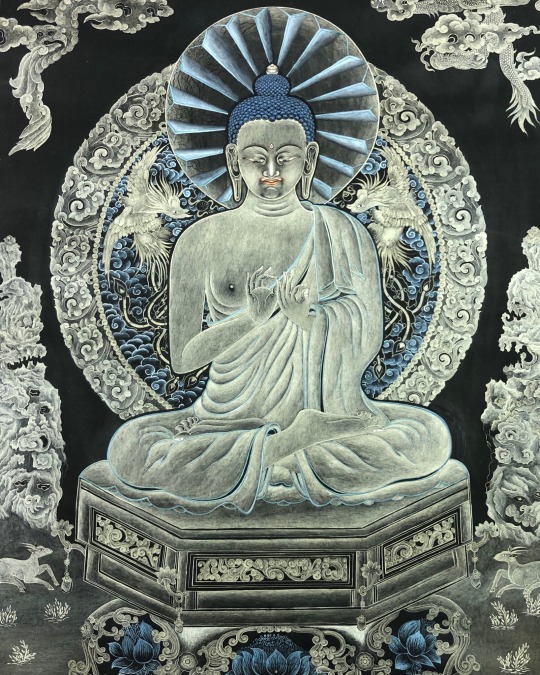
2 notes
·
View notes
Text
Delirium
Watercolor, gouache, pencil, and ink on paper. 59.62"×40.12" 2004
The Eagle was immediately conveyed to my place of residence, covered by a blanket, to save him, in his adversity, from the gaze of the people. I placed the cage so as to afford me a good view of the captive, and I must acknowledge as i watched his eye, and observed his looks of proud disdain, I felt towards him not so generously as I ought to have done. At times I was half inclined to restore him to his freedom, that he might return to his native mountains; nay, I several times thought how pleasing it would be to see him spread out his broad wings and sail away towards the rocks of his wild haunts; but then, reader, some one seemed to whisper that I ought to take the portrait of the magnificent bird, and I abandoned the more generous design of setting him at liberty, for the express purpose of showing you his semblance.
I occupied myself a whole day in watching his movements; on the next I came to a determination as to the position in which I might best represent him; and on the third I thought of how I could take away his life with the least pain to him. I consulted several persons on the subject, and among other my most worthy and generous friend, George Parkman, Esq. M.D., who kindly visited my family every day. He spoke of suffocating him by means of charcoal, of killing him by electricity, &c. and we both concluded that the first method would probably be the easiest for ourselves, and the least painful to him. Accordingly the bird was removed in his prison into a very small room, and closely covered with blankets, into which was introduced a pan of lighted charcoal, when the windows and doors were fastened, and the blankets tucked in beneath the cage. I waited, expecting every moment to hear him fall down from his perch; but after listing for hours, I opened the door, raised the blankets, and peeped under them amidst a mass of suffocating fumes. There stood the Eagle on his perch, with his bright unflinching eye turned towards me, and as lively and vigorous as ever! Instantly re-closing every aperature, I resumed my station at the door, and towards midnight, not having heard the least noise, I again took a peep at my victim. He was still uninjured, althought the air of the closet was insupportable to my son and myself, and that of the adjoining apartment began to feel unpleasant. I perservered, however, for ten hours in all, when finding that the charcoal fumes would not produce the desired effect, I retired to rest wearied and disappointed.
Early the next morning I tried the charcoal anew, adding to it a quantity of sulphur, but we were nearly driven from the home in a few hours by the stifling vapors, while the noble bird continued to stand erect, and to look defiance at us whenever we approached his post of martyrdom. His fierce demeanour precluded all internal application, and at last I was compelled to resort to a method always used at the last expedient, and a most effectual one. I thrust a long pointed piece of steel through his heart, when my proud prisoner instantly fell dead, without even ruffling a feather.
I sat up nearly the whole of another night to outline him, and worked so constantly at the drawing, that it nearly cost me my life. I was suddenly seized with a spasmodic affection, that much alarmed my family, and completely prostrated me for some days; but, thanks to my heavenly Preserver, and the friends Drs Parkman, Shattuck, and Warren, I was soon restored to health, and enabled to pursue my labours. The drawing of this eagle took me fourteen days, and i had never before laboured so incessantly excepting at that of the Wild Turkey.
-John James Audubon, Ornithological Biography, E.L. Carey and A. Hart 1832
Walton Ford's Pancha Tantra published by Taschen
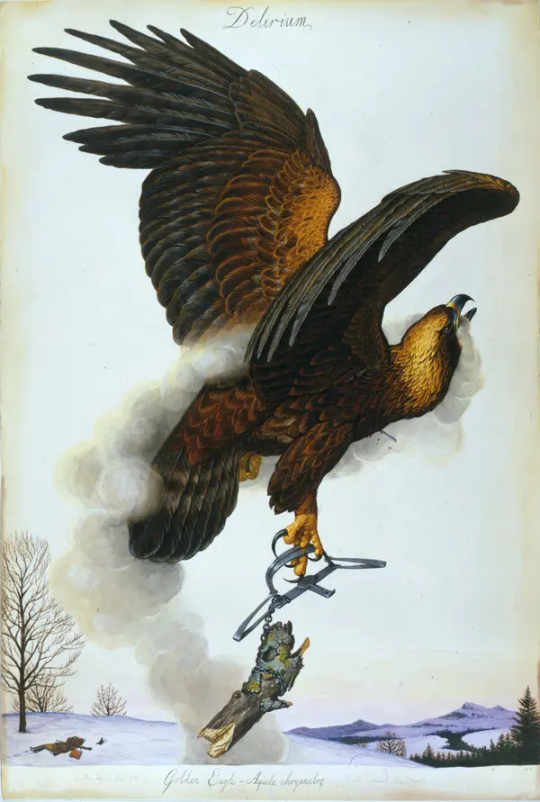
Delirium, Walton Ford, 2004
#animal death#walton ford#audubon kinda like#sucked as a guy#all his illustrations were birds he trapped and killed#including seriously fucking up some now extinct bird populations just to get a model#walton fords works that directly deal with audubon are incredible
129 notes
·
View notes
Text
Transformation of Energy – Part -1
During the process of coming into one's own, the highest goal is seen as a small version of Sakti, the goddess of feminine power, linked to Kundalini's awakening. Tantric practitioners connect Sakti's power to Cosmic Consciousness because she shows how male and female ideals can exist together.
Tantra-asanas, also called "sexo-yogic postures," has become a powerful set of mental and physical practices requiring the same discipline as meditation to bring about this realization. The Kundalini Sakti can be awakened through the practice of tantra-yoga-asanas. This is in line with the teachings of tantra, which say, "One must rise by that by which one may fall." On the biological level, the fusion of polarities is called the sexual union of asana. As is often and wrongly said, this is not the same as having a "sexual encounter."
Having sex has always been linked to having children or feeling very satisfied with one's body. Tantrikas, on the other hand, knew that sexual energy had a huge amount of potential and was able to use tantra-asanas to change sexual energy and set it free on a level of cosmic awareness. People think that sexual activity is inherently divine and a source of vital energy that can hugely affect a person's physiopsychic state, which then affects a higher level of the universe.
Tantra is a spiritual practice that tells a man and a woman how to behave in a way that turns their sexual union into the spiritual union of Siva and Shakti. Dakshina marga, also called the "right-hand path," and Vama marga, also called the "left-hand path," are two of the most important tantric practices that can be done to awaken Kundalini. People who follow the left-hand path use Pancha-Makara, which is a term for five ritual ingredients that start with the letter M. These are madya, which is wine, mamsa, which is meat; matsya, which is fish; mudra, which is dried cereal, and maithuna, which is sexual union. Chakra-puja is the name for the ritual of a group of people getting sexually intimate in a circle. The central idea of the left-hand path is that we can't make spiritual progress by denying or avoiding our desires and passions. Instead, we need to change those things that cause us to fall as a way to become free. This is the basic idea that the left-hand path is based on.
Through the practice of Kundalini Yoga, the flow of Kundalini Sakti, which normally moves downward, can be made to move in the opposite direction. This brings it together with Siva, or Cosmic Consciousness, in the end. To reach this goal, the body's physiological functions also gradually change.
Tantra-asana is an exercise that must be done with someone of the opposite gender. People think that the female participant reflects Sakti, the dynamic female principle that underlies everything in the universe. The "devout woman" is the perfect example of what it means always to be a woman. With the help of a guru, a place is chosen for the ritual, and the best time of day and hour are figured out before it starts. The best way to get started is to get initiation from a Bhairavi (female guru). Tantrikas put a lot of emphasis on the fact that rituals must be done in places far away from other people and free of noise and pollution. Rituals like bathing, dressing, worshiping, giving flowers and other ritual items, and doing rites like Nyasa and bhuta-sudhi, which involve cleaning the body and the elements, are done to set the right mood. In vamachara, which is also called left-hand practice, the instructions are taken literally, while in dakshinachara, which is also called right-hand practice, they are taken symbolically.
During the Pancha-Makara rite, the unclothed female deity worshipped is no longer seen as a person. Instead, she is seen as the goddess Sakti, representing the most basic parts of the universe. ' The transmission of divine power is not something that happens in a separate realm from the real world. Instead, it is something that can be learned through experience. The man and the woman are both playing parts in a play following the letter. In this discussion, there is no room for abstract ideas. Instead, there is a constant reference to a real human condition. Their thoughts and feelings move in sync with each other when they talk. So, the fact that a woman can turn into a goddess is a very special insight into the real world. This is because a woman's change into a goddess can't be seen, felt, or understood in any way other than what it is.
"The man and the woman meet themselves in each other, and by doing so, they can connect with their inner selves in a fuller way." This ongoing activity of "seeing" into each other through the different ritual acts leading up to sexo-yogic asana throws the group into anonymity so they can accept the common goal. Sexo-yogic asana. Ritual projection gives divinity to the adepts, which continues until both males. Female adepts, who represent the rational principles, reach an existential awareness of unity that is like the circle symbol. For more information you can search for
Yoga and Meditation in Rishikesh.
#Ayurvedic Detox Programs in Rishikesh#yoga and meditation in rishikesh#Ashram Stay in Rishikesh#Authentic Yoga School in Rishikesh#Yoga Teacher Training in Rishikesh
3 notes
·
View notes
Text
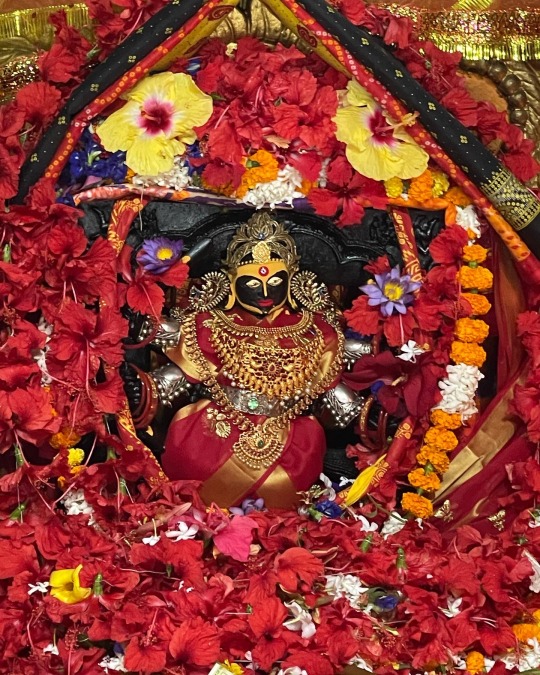
#ugratara #temple #odisha
Tara comes from SITA RAM it has TA of Sita and RA of RAM.
According to #Yogini #Tantra, #Tara is the same as #Kali , the embodiment of supreme #love. She is also #Kamakhya. In Tantric literatures three manifestations of Tara are mentioned: Eka Jata, providing Kaivalya or unity with the Absolute; Ugra Tara, one who provides relief from unforeseen severe meseries and Nila Saraswati, imparting Jnana or knowledge.
She stands in the Pratyalidha pose. She is short stature with a protruded belly and Her complexion is dark blue. She has a terrible appearance away from her mild and pretty Sarasawati appearances. She wears tiger skin at Her waist and garland of human-heads at Her neck.
She is of prime youth and adorned with Pancha Mudras. In Her four hands She holds Khadga-sword, Indivara-lotus, Kartika-shear and Kapala-human skull. Her tongue is held out as Kali’s lolling tinge. She wears single braid of matted hair on her head. Tara is three-eyed as she stands on the corpse lying on the burning funeral pyre and ranges her feet, which appears terrible. These are symbolic of Mother Kali, ever ready to remove the darkness of ignorance and passiveness of Her devotees. Ma Tara is synonymous with Omkar, the five
components of Omkar are – A, U, M, Nada and Bindoo
What I love the most of compassionate is her mother love for #shiva
The legend begins with the churning of the ocean between the Devas and Asuras. Lord Shiva drank the poison that was created from the churning of the ocean (in the process turning his throat blue and earning him the epithet Nilakantha), thus saving the world from destruction, but fell unconscious under its powerful effect. Tara Ma appeared and took Shiva on her lap. She suckled him, the milk from her breasts counteracting the poison, and he recovered. It is reminiscent to Kali's maternal instinct when Shiva stops the rampaging Kali by becoming an infant and Kali becomes quiet and nurses the infant Shiva. In both cases, Shiva assumes the position of an infant vis-à-vis the Goddess.
May the compassionate Ma Ugratara shows us the way from #darkenesstolight
ॐ त्रीं ह्रीं, ह्रूं, ह्रीं, हुं फट्॥
Om Treem Hreem, Hrum, Hreem, Hum Phat॥
3 notes
·
View notes
Photo


Parable of Returning Love for Hatred
the story is about a robbery victim (almost certainly a Jew) who was found half-dead on the road to Jericho. A Jewish priest and a Levite refused to assist, possibly because they suspected a plot or were afraid of being robbed if they stayed. But it was a Samaritan (whom the Jews despised) who came to the victim’s aid, administered first aid, took him to an inn, and made provisions for his care. A Jew truly needy was a friend to the Samaritan.

The Pachatantra
Panchatantra in instilling moral principles in children. This story teaches us how difficult it is to regain someone's trust once it has been shattered. Lying can help you survive for a brief period of time, but if it becomes a habit, you will quickly lose friends.
While entertaining, Panchatantra teaches the value of justice and imparts important life lessons. It never becomes drab and never loses interest due to the use of the animal world. Panchatantra is a Sanskrit term ('Pancha' – five, and 'tantra' – systems) that contains nearly 50 stories divided into five volumes.

The Lionmakers
The story of the lion maker is fantastic. It is about wisdom and understanding, about appreciating what we have. According to the story's point of view, even if you have a higher level of learning than others, if you don't use your senses, you'll fail in the end because every action, right or wrong, has a consequence. The story's main theme is to seek intelligence rather than rely on what you already know, and to think carefully before acting.
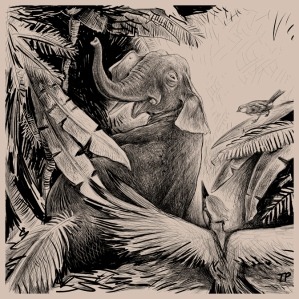
The Duel Between the Elephant and the Sparrow
Things aren't fair; you'll be punished even if it wasn't your fault. And we know from the story that the elephant is being sought. Before exacting revenge, the sparrow should first learn the elephant's explanation. I feel sorry for the elephant, but on the other hand, the sparrow is a wonderful parent for taking revenge for the loss of his children. The lessons I've learned are that it's not necessary to first learn the truth before doing bad things to everyone else. and also you need to listen of what the other explanation about before you revenge to that person.
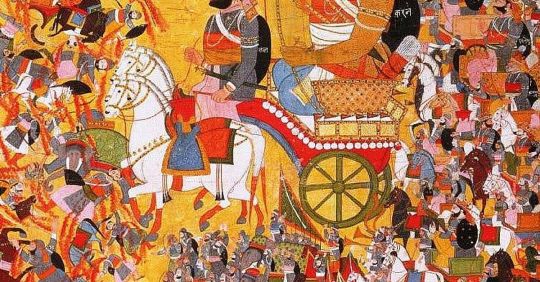
The Mahabrata
Mahabharat is a very special time for everyone, including family, friends, society, and the country. Its teachings point the way to the truth in everyone's life. If you are on the path of truth and encountering difficulties, but someone you know is prosperous despite engaging in immorality, unrighteousness, and false deeds, and is wealthy, do not abandon your path after seeing him. Your eyes can only see what is happening right now, not what will happen in the future. It is the responsibility of parents and gurus to pass on knowledge to their children, but knowledge without discretion and good intellect leads to destruction. As a result, in addition to knowledge, wisdom and good values must be imparted.

The Ramayana
The thing to learn here is to be an idealist and to react favorably even in the face of adversity. Hanuman is a symbol of devotion, determination, courage, and a single-minded focus on completing a task. Another critical point is that Hanuman's focus is solely on his duty, not on the reward. Correspondingly, we are supposed to concentrate on our respective tasks rather than on the rewards or benefits. The greatness of the Ramayana is limitless. It is a veritable knowledge mine. The principles of the Ramayana transcend all time and space. We can move from darkness to light by adhering to these precious life principles.
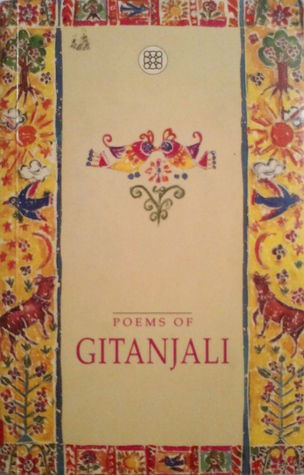
Gitanjali- collection of poems
This book contains all of the possible human and spiritual values that a person requires to be in harmony with himself/herself, society, and the world, the universe at large. Tagore's lyrics are distinguished by their variety of themes, but it is the demonstration of divine power in all objects and aspects of the Universe. He wrote lyrics about God, Love, Nature, Children, World and Humanity Love, and so on. No other poet, not even Sarojini Naidu, dubbed "India's Nightingale," has written lyrics on such a wide range of subjects. Tagore's lyrics capture the theme and spirits of Indian philosophy, vividly evoking the Indian atmosphere and the influence of the Upanishads.

HEBREW LITERATURE
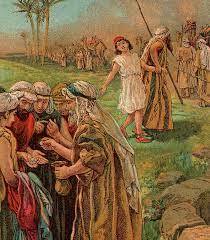
The Story of Joseph
Joseph's dreams get him into trouble at first, but his ability to interpret them leads to him being picked by the Pharaoh and saving the world. We could learn a thing or two about the workings of the universe. It can be interpreted by both believers and non-believers as an indication of the necessity to keep trying and persevering.
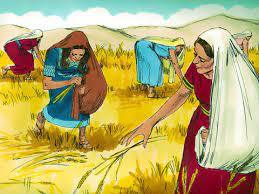
The Story of Ruth
Ruth's story is one of faith and obedience. It's about those who find their way in the dark, trusting that God will guide them to their destination. We can learn a lot from it.
Ruth was able to accomplish something extraordinary. Despite her circumstances, she was able to maintain her optimism and avoid becoming bitter. And she was able to maintain her humility when things began to go well for her. This is an important lesson for Christians to learn. That no matter how low or high we fall, we can remain hopeful and humble, trusting God to help us get through it.
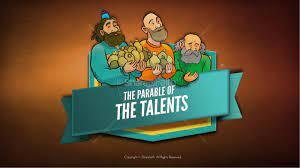
The Parable of Talents
This story is known as the Parable of the Talents. That title is a little misleading. The term "talents" refers to gold or silver weights rather than a special ability. Although accurate study necessitates clarification of the term "talents" used in the text, the modern definition of the word also fits the lesson. In fact, the modern definition of the word may have been influenced in part by this parable. Jesus' point is that we should do our best for the Kingdom with the resources we have (money, abilities, time, and intelligence) until He returns.

PERSIAN LITERATURE

Hell of Heaven
It represents a fulfilled desire in Heaven and a soul in fire in Hell. Heaven is only the Vision of a Fulfilled Desire, and Hell is the Shadow of a Soul on Fire, cast on the darkness into which we have fallen.
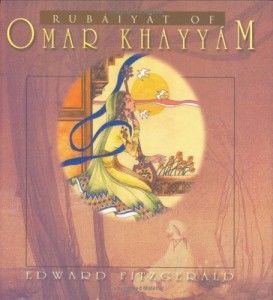
The Rubaiyat of Omar Khayyam
It is the most popular Persian poet of the nineteenth and early twentieth centuries (1048–1123). Khayyam is regarded more as a scientist than a poet in his native Persia, but in Fitzgerald's interpretation, he became one of the most quoted poets in English. Omar Khayyám's Rubáiyát is a quatrain-based lyric poem (four-line stanzas). A lyric poem, rather than telling a story with characters, expresses the poet's deep feelings and emotions on topics such as life, death, love, and religion.
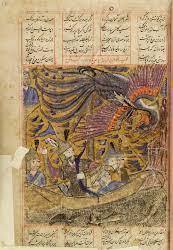
The Shah amah
The Shahnameh (Book of Kings), completed by Abolqasem Ferdowsi in the early 11th century, is not only a literary masterpiece, but also a book that has helped define Iran and the Iranian peoples for centuries, as well as safeguard the survival of the Persian language. Even though the large percentage of the stories in the Shahnama entail fights and struggles between good and evil forces, other motifs in the Shahnama include love, humor, and the supernatural. One of the major themes is kingship and the relationship between rulers and their subjects.
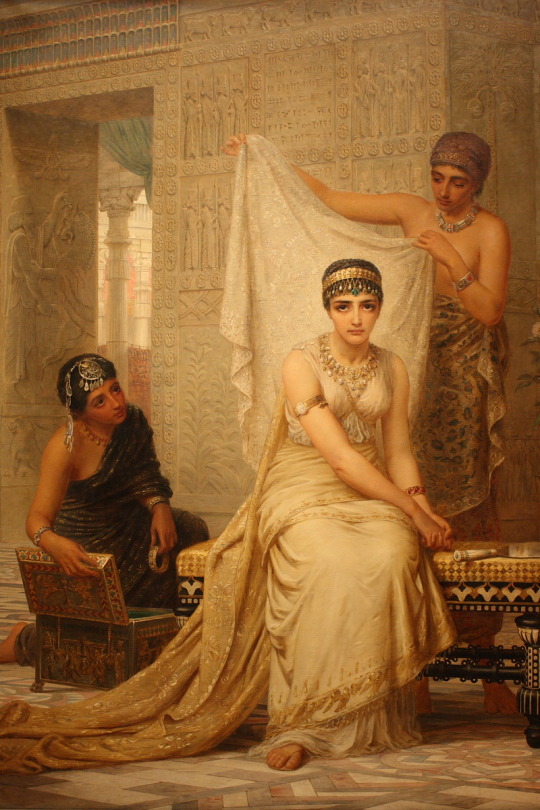
The Beautiful Queen of Persia - Esther, the lovely Jewish wife of the Persian king Ahasuerus (Xerxes I), and her cousin Mordecai persuade the king to reverse an order for the annihilation of Jews throughout the empire.
The Book of Esther is a Jewish novella about preserving Jewish identity and ensuring survival in the face of cultural pressures and hostile enemies in a foreign land.

The Prince of Persia
Jordan Mechner created The Prince of Persia in 1989. His inspiration for the character came primarily from Middle Eastern literature, such as One Thousand and One Nights, and his athleticism was inspired by the opening scene of Raiders of the Lost Ark. The Prince of Persia is a timeless love story that incorporates biblical and mythological themes.
The lessons of "Prince of Persia" are true: love is stronger than evil; selfish ambition can destroy us all; and trust and mercy are essential for relationships and national security.
1 note
·
View note